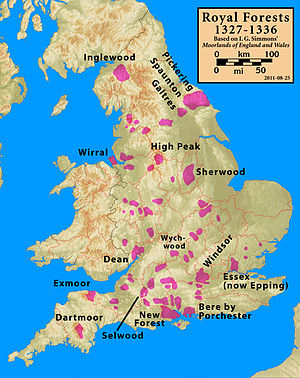Forest of High Peak


The Forest of High Peak was, in medieval times, a moorland forest covering most of the north west of
The south western area between the River Wye and Kinder Scout was relatively open country, which was enclosed by a low wall, sufficient to keep out cattle and sheep but allow the deer to roam. The area was known as Campana,[2] the other two being Hopedale and Longdendale. The point where they met is to this day marked by Edale Cross.
As well as his custodianship of the Forest, William also held a number of
However, in 1154 the estate was confiscated by
Records document the deer, wild pigs, wolves, horses and sheep in the forest. Anyone caught breaking the laws of the forest was taken to the Peak Castle at Castleton, from where the High Steward administered the forest. The present village of Peak Forest is at the heart of the area of the old royal forest and was formerly known as Chamber of Campana. The nearby Chamber Farm or Chamber Knoll may have been the exact location of the residence and meeting place of local forest officials.[3]
Notes
- ISBN 0 86023 286 7.
- ^ Champaign, or "open country".
- ^ Hadfield, Roger (1985). "An outline history of Peak Forest and Dove Holes". Rootsweb. Retrieved 12 April 2020.
References
Turbutt, Gladwyn (1999) A History of Derbyshire. Volume 2: Medieval Derbyshire. Cardiff: Merton Priory Press ISBN 978-1898937340
